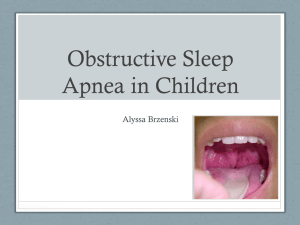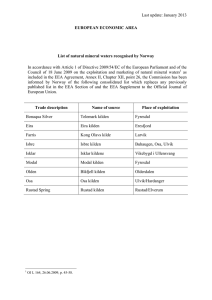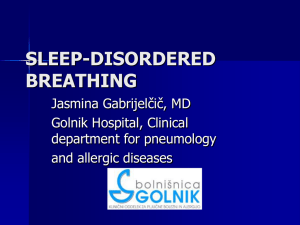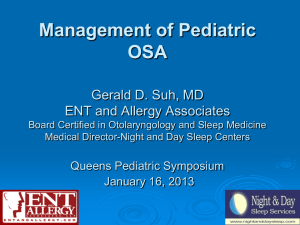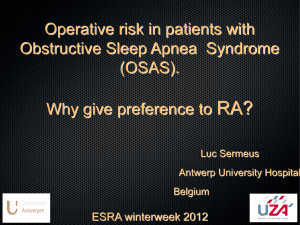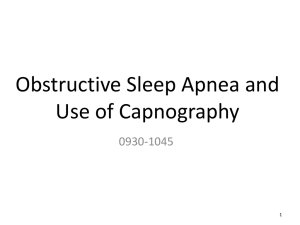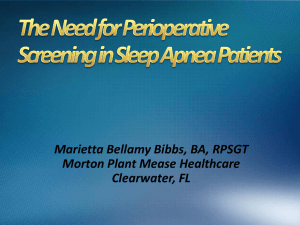This is the Novant Health PowerPoint 2003 Template
advertisement
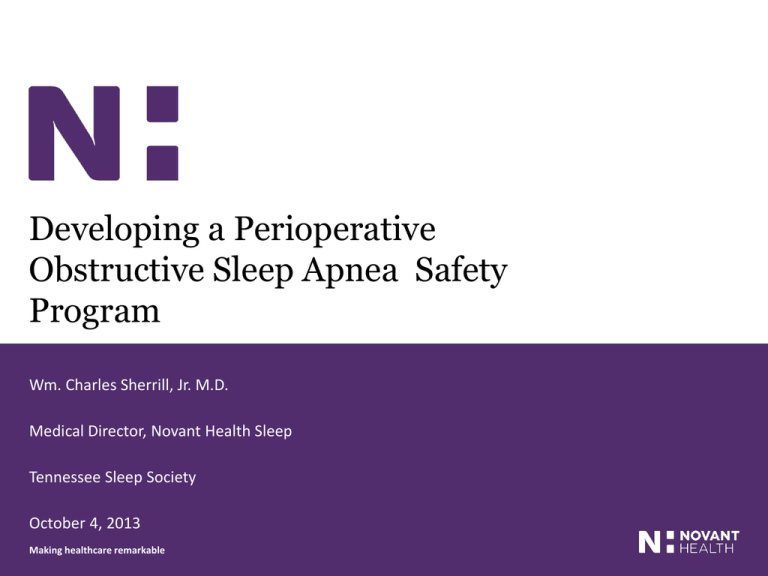
Developing a Perioperative Obstructive Sleep Apnea Safety Program Wm. Charles Sherrill, Jr. M.D. Medical Director, Novant Health Sleep Tennessee Sleep Society October 4, 2013 Making healthcare remarkable Screening Tools for OSA Sleep Disordered Breathing Simple snoring Upper airway resistance syndrome (UARS) Obstructive sleep apnea Central sleep apnea with or without Cheyne-Stokes Respirations Complex sleep apnea Unobstructive hypoventilation Clinical Scenario 45 year old male, 320 lbs and 5’11” had a rotator cuff repair under general anesthesia. The intraoperative course was uneventful. He was admitted to the ward for overnight pain control. Four hours after surgery, he received an intramuscular injection of Meperidine 100 mg with Phenergan 25 mg. This was repeated 3 hours later when severe pain prevented him from sleeping. Two hours later, nurses making a routine check found him to be in full arrest. He could not be resuscitated. The internist’s history and physical mentioned his having been diagnosed with sleep apnea. Ann Lofsky. M.D. Sleep Apnea and Narcotic Postoperative Pain Medication: A Morbidity and Mortality Risk OSA and the Surgical Patient Malpractice cases involving Obstructive Sleep Apnea in Hospitalized Patients – Intubation complications (20%) – Extubation difficulties (10%) – Post operative catastrophes (70%) Drug induced respiratory arrest resulting in death/brain damage Patients with OSA with inadequate monitoring OSA and the Surgical Patient Postoperative catastrophes (“Dead in bed”) Severe OSA Morbid obesity Isolated ward room No monitoring Receiving narcotics Off O2/PAP Jonathan L. Benumof, M.D. The Balance of Forces (Malhotra & White, 2002) OSA and the Surgical Patient Obstructive Sleep Apnea As a consequence of the previous factors patients with OSA are increasing dependent on the activity of the pharyngeal dilator muscles for airway patency. OSA patients demonstrate increased EMG activity in the pharyngeal dilator muscles (Genioglossus muscle) during wakefulness. The reduction in EMG activity in these muscles at sleep onset is greater in OSA patients than normals. OSA patients have a reduced ability to compensate for factors that predispose them for upper airway collapse – Increased negative pharyngeal pressures during inspiration – Reductions in upper airway muscle tone OSA and the Surgical Patient Impact of sedatives, anesthetics, and analgesics (opioids) on respiratory function – Dose dependent depression of muscle activity of the upper airway muscles Depression of central respiratory output/upper airway reflexes – Increased collapsibility of the upper airway Direct action (peripheral) on hypoglossal (tongue) and phrenic (diaphragm) nerves – Phrenic nerve depression – decreases in lung volume Alterations in apneic threshold/sensitivity to hypoxemia Alterations in the chemical/metabolic/behavioral control of breathing OSA and the Surgical Patient Sympathetic nervous system activation (catecholamine excess) Surgical stress Hpoxemia/Hypercarbia Arousals Related to an increased risk of cardiac arrhythmias, cardiac ischemia and hypertension . Majority of unexpected and unexplained postoperative deaths occur at night and within 7 days of surgery. Rosenberg, J. et al British Journal of Surgery 1992. OSA and the Surgical Patient Postoperative factors: Pain management: use of opioids Positioning: supine position Sleep fragmentation with potential REM rebound Comorbid conditions OSA and the Surgical Patient What is the scope of the problem? How does the surgical process affect individuals with obstructive sleep apnea? Does Obstructive sleep apnea result in postoperative complications more frequently than the non-OSA surgical population? Obesity Trends* Among U.S. Adults BRFSS, 1990, 1998, 2007 (*BMI 30, or about 30 lbs. overweight for 5’4” person) 1990 1998 2007 No Data <10% 10%–14% 15%–19% 20%–24% 25%–29% ≥30% OSA and the Surgical Patient Critical points of the NHANES data Prevalence of clinically severe obesity is increasing much faster than that of moderate obesity. Strum, R. Increase in morbid obesity in the USA. Public Health 2007, 121(7), 492496. Data from 2000-2005. BMI > 40 kg/m2 has increased fivefold 1:200 adults to 1:33 adults BMI > 50kg/m2 has increased tenfold 1:2,000 adults to 1:200 adults OSA and the Surgical Patient Prevalence of undiagnosed obstructive sleep apnea among adult surgical patients in an academic medical center. Finkel, K. et. al. Sleep Medicine. 2009. 10, 753-758. Prospective, observational study. ARES screening questionnaire 661/2877 (23.7%) screened positive high risk for OSA. 534 /661 (82%) screened positive no previous diagnosis of OSA 207/661 valid 2 night HST 73/207 (35%): moderate to severe OSA OSA and the Surgical Patient The STOP-BANG Questionnaire Identified the Patients with Significant Exacerbations of Sleep Disordered Breathing during the Perioperative Period. P. Liao et al. 67 patients: STOP-BANG + limited channel testing – 20 low risk : Score < 3; 47 high risk: Score >3 – High Risk patients Pre operative AHI 10.2/hr. PON 1 AHI 13.2/hr. PON 3 AHI 23.2/hr. PON 5 AHI 17.9/hr. PON 7 AHI 16.0/hr. – STOP-BANG 6-8 predictive of patients with higher AHI OSA and the Surgical Patient Kaw, R. et al. Chest 2012; 141(2); 436-441 IM preop assessment and PSG databases crossmatched to identify patients underwent both PSG and non cardiac surgery. – 1784 pts , 471 pts eligible for study: 269 (57%) had OSA – Presence of OSA associated with: Increased incidence of significant hypoxia (p=0.02) Reintubation (p=0.048) Unplanned ICU transfer (OR=7.6) Overall complications (OR=9.9) Longer length of hospital stay (OR=1.9) OSA and the Surgical Patient Postoperative complications Higher reintubation rates Hypoxemia / Hypercarbia (+)/(-) (+) Arrhythmias Myocardial ischemia Increased transfers to higher level of care (+)/(-) Increased length of hospitalization (+)/(-) Delirium Reationship to severity of OSA (AHI) (+) / (-) OSA and the Surgical Patient Screening Tools for OSA Prevalence of obstructive sleep apnea appears to be increasing in association with the increase in obesity. The prevalence of obstructive sleep apnea in individuals presenting for surgery will be increasing in the future. Results would suggest that currently approximately 25%-30% of indviduals presently for surgery will screen positive for obstructive sleep apnea. (Based primarily on screening questionnaires). These patients are at increased risk for complications and death that may be reduced with appropriate screening, diagnosis and therapy. **Clinical Management Strategy** Preoperative Screening (Identification) Flag patients with positive screen Monitoring (Keeping the patient safe) Decide on a monitoring strategy Have an action plan Measure outcomes Discharge (Longitudinal evaluation and care) OSA and the Surgical Patient OSA patients will present for surgery in one of three ways: Known OSA compliant with therapy Known OSA – Mild OSA – therapy not recommended – Refused therapy or non compliant – Therapy instituted – weight loss, surgery, dental appliance: status unknown Unrecognized OSA – Goal: Minimize the number of these patients presenting for surgery OSA and the Surgical Patient Screening Tools for OSA Why do we need a mechanism for screening? F. Chung. Proportion of Surgical Patients with Undiagnosed Obstructive Sleep Apnoea. BJA 2013 – 819 pts (surgical population) underwent a sleep study: 234 pts in lab PSG; 585 pts 10 channel HST Surgeons/anesthesiologists not informed of PSG results. Clinical diagnosis of OSA made by physician noted by record review. – 138/819 patients had severe OSA (AHI > 30) (17%) 118/138 (86%) were not identified by surgeons 65/138 (47.1%) were not identified by anesthesia OSA and the Surgical Patient Screening Tools for OSA Criteria for Screening Tests Disease features – Disease significantly impacts public health – Intermediate probability of disease – Detection occurs before a “critical point” Critical point occurs before clinical diagnosis Critical point occurs in time to affect outcome Test features – High test sensitivity to detect minimal disease – High test specificity to minimize false positives – Screening test tolerated by patients OSA and the Surgical Patient Screening Tools for OSA Important features: Easy to understand Ease of administration/scoring Limited time requirements Sensitivity/Specificity Validated (PSG) Generalizable to various patient populations – Primary care, surgical, medical, sleep clinic OSA and the Surgical Patient Screening Tools for OSA Purpose of OSA Screening (Identification) Eliminate or markedly reduce the unrecognized OSA patients present in a given clinical population Stratify patients s relates to OSA risk; those at high risk expedited evaluation and treatment or higher acuity of monitoring. Early identification and treatment may have positive impact on associated comorbid conditions Limitation: Screening does not discriminate between mild and moderate/severe OSA. Does not identify true “at risk” patients. OSA and the Surgical Patient Screening Tools for OSA Screening Questionnaires Berlin Questionnaire ASA Checklist STOP and STOP-BANG questionnaire Sleep Apnea Clinical Score (SACS) (Flemons) Perioperative Sleep Apnea Prediction Score (P-SAP) Sundar, E., Chang, J., Smetana, G. (2011). Perioperative Screening for and Management of Patients with Obstructive Sleep Apnea. Journal of Clinical Outcomes Management, 18(9), 399-411 OSA and the Surgical Patient A Higher Score on STOP-BANG was Associated with a Higher Incidence of Post-Operative Complications. F. Chung, P. Liao 862 pts: STOP-BANG and overnight HST (10 channel) STOP-BANG Complications: All Exclude SaO2 – 0-2 (25%) 39.9% 4.2% – 3-5 (62%) 54.3% 14.2% – 6-8 (13%) 66.1% 18.3% – Associated with higher AHI post operatively Both cardiac and pulmonary complications increased with increasing score; not neurologic OSA and the Surgical Patient Screening Tools for OSA The STOP-BANG Equivalent Model and Prediction of Severity of OSA: Relation to PSG Measurements of the AHI. Farney, R. et. al. Jr of Clinical Sleep Medicine, 2011, Vol 7, No 5, 459-65. 1426 pts clincal data converted to SB with PSG This study looked at the probabilities of no, mild, moderate, severe OSA at each SB score from 0-8. Progressive increase in probability of severe OSA (4.4% to 81.9%) and progressive decrease in the probability of no OSA (52.5% to 1.1%) Results: the greater the single cumulative score on the STOPBANG the greater the probability of more severe sleep apnea. OSA and the Surgical Patient Screening Tools for OSA Stratification using the STOP-BANG (Chung, F.) STOP-BANG score 0-2 Low risk of OSA STOP-BANG score 3-4 Indeterminate risk of OSA STOP-BANG score 5-8 High risk of OSA OSA and the Surgical Patient Screening Tools for OSA Validation of the Berlin Questionnaire and American Anesthesiologists Checklist as Screening Tools for OSA in Surgical Patients. Chung, F. et al. Anesthesiology V 108 No 5 May 2008, 822-830. Preoperative pts 18 yrs or older and without previously diagnosed OSA. 2,467 patients were screened using the three screening tools Performance of the screening tools evaluated in 177 patients that had PSG. OSA and the Surgical Patient Screening Tools for OSA Classified as high risk of OSA Berlin Questionnaire 33% ASA Checklist 27% STOP Questionnaire 28% No significant difference in the questionnaires in the ability to identify patients with OSA. Approximately 30% of general surgical patients will screen positive for OSA. OSA and the Surgical Patient Screening Tools for OSA Data suggests that the use of screening questionnaires can reliably identify patients at risk for obstructive sleep apnea. Sensitivity and negative predictive value good. Specificity fair False positive rate is 15%-20%. Use of any of the screening tools improves the likelihood of identifying obstructive sleep apnea. OSA and the Surgical Patient Screen positive for Obstructive Sleep Apnea. Now what? Evaluate and institute therapy prior to surgery or postoperatively Treat at risk patients empirically postoperatively Use of algorithms to determine “at risk” patients Monitor high risk patients perioperatively Intervene with therapy for cardiopulmonary difficulties. Evaluation and definitive therapy after discharge. OSA and the Surgical Patient Sleep Consultative Service: Sleep physician Physician extenders “Super nurse” – Antic, N.A. Am J Respir Crit Care Med vol 179. p 501-508, 2009 Sleep technician/Respiratory therapist/ Sleep navigator Template: symptoms, comorbid conditions, physical exam OSA and the Surgical Patient Diagnostic testing: In lab polysomnography Limited channel testing (portable sleep testing) Autonomic measures of sleep disordered breathing – Peripheral arterial tone (PAT) – Cardiopulmonary coupling (CPC) Limiting factors Time constraints – Diagnostic study – Acclimation to PAP What to do with patients that refuse study? OSA and the Surgical Patient Evaluate and treat patient preoperatively OSA and the Surgical Patient Retrospective observational study: 2 years: 431 patients screened +; 211 PSG (split) CPAP offered to moderate/severe OSA. Results – 49% completed the sleep study. – 138/211 (65%) had moderate to severe OSA – Median adherence (30 days) 2.5 hours. – Split night study was completed an average of 4 days prior to surgery. CPAP Adherence in Patients with Newly Diagnosed Obstructive Sleep Apnea prior to Elective Surgery. Gurainick, A. et al. Jr. Clin Sleep Med. Vol 8, No 5, 2012. 501-506. (U of Chicago) OSA and the Surgical Patient Treat at risk patients post operatively OSA and the Surgical Patient Does Autotitrating Positive Pressure Therapy Improve Postoperative Outcomes in Patients at Risk for OSAS. O’Gorman et. al. Chest 144 No 1, July 2013, 72-78. 138 patients (screened 2,375 pts) SACS > 15 high risk – 52 pts low risk; 86 pts high risk (62%) – HR pts: 43 pts routine care; 43 pts routine care + APAP. – Night before D/C. Type III sleep study Primary endpoint: Length of stay Secondary : ICU transfer, SpO2, cardiopulmonary events OSA and the Surgical Patient Results: No change in LOS; no difference in rate of postoperative complications. Issues: – APAP use night 1: 373 mins; median use 184.5 mins. – Incomplete resolution of sleep apnea AHI: 22.2 per hour to 13.5 per hour Unable to differentiate obstructive vs central apnea. P95%: 9 cm. OSA and the Surgical Patient Treat “at risk” patients empirically postoperatively Risk stratification algorithms – Intensity of surgery and type of anesthesia – Use of postoperative narcotics – Comorbid conditions – PACU course* OSA and the Surgical Patient Monitor level of sedation Richmond Agitation Sedation Scale (RASS) Ramsey Sedation Scale Pasero Opioid-Induced Sedation Scale (POSS) – S = Sleeping, easy to arouse – 1 = Awake and alert – 2 = Slightly drowsy, easily aroused – 3 = Frequently drowsy, arousable, drifts off to sleep during conversation * – 4 = Somnolent, minimal or no response to verbal or physical stimulation * *requires action Joint Commission Sentinel Event Alert No. 49 August 8, 2011. Safe use of opioids in the hospital. OSA and the Surgical Patient Post operative management Multimodality pain management – NSAID’s – Acetominophen – Tramadol – Ketamine – Gabapentin/Pregabalin – Clonidine – Dexamethasone – Dexmedetomidine (Precedex) Alpha 2 agonist Post operative oxygen desaturation 12-14 times more likely in OSA patients receiving opioid analgesia compared with non-opioid analgesia. – Bolden, N. et al. Anesth Analg 2008; 105: 1869-70. OSA and the Surgical Patient CoMorbidities: should they be considered in the assessment of level of monitoring? Higher Risk: – Atrial fibrillation* – Congestive heart failure* – Severe COPD – Coronary artery disease* – Obesity Hypoventilation Syndrome – Pulmonary Hypertension Kaw, R. Respiratory Medicine 2011, 105, 619-624. – Uncontrolled Hypertension* Lower Risk: – Mild COPD – Hypertension – Diabetes Mellitus – Cerebrovascular disease* – Obesity BMI > 35 kg/m2* OSA and the Surgical Patient Obesity Hypoventilation Syndrome Meta analysis: prevalence of 19% in pts with OSA 3% in general population Obesity Hypoventilation Syndrome: an Emerging and Unrecognized Risk Factor Among Surgical Patients. Kaw et al. AJRCCM 183;2011; A3147 1784 patients both PSG and non cardiac surgery 471 eligible; 269 (57%) OSA 36/269 (13%) had ABG data. 9/36 (3%) criteria for OHS 14/269 (5%) post operative respiratory failure 44% OHS/OSA 3% OSA OSA and the Surgical Patient Obesity Hypoventilation Syndrome Should include screening for OHS ? Screening all patients with OSA/+screen and BMI > 35 with awake ABG not practical Initial screen: – HCO3 > 27 sens 92% spec 50% for hypercapnea Mokhlesi, B. et al. Sleep and Breathing 2007; 11; 117-24. – Resting wake SpO2 < 93%. Piper, A. Sleep Medicine Review 2011; 15; 79-89. If both positive: resting wake ABG. Consider preoperative sleep consultation. – Use of APAP inappropriate in these patients (AASM guidelines). Require titration to determine appropriate PAP therapy. OSA and the Surgical Patient Sleep-Disordered Breathing in Hospital Patients: Identifying and Treating Patients at Risk. Gay, P. Use of Sleep Apnea Clinical Score (SACS) to screen 693 patients non cardiac surgery Likelihood of postoperative respiratory events – High SACS: OR: 3.5 – High SACS and Recurrent events in PACU: OR: 21 Course in PACU appears to be most predictive of subsequent postoperative respiratory events. OSA and the Surgical Patient PACU experience (Mayo Clinic) Initial evaluation period – 30 minutes after extubation or PACU arrival (whichever is later) 2nd and 3rd evaluation periods at 30 minute intervals. Criteria – Hypoventilation: < 8 bpm ( 3 episodes for yes) – Apnea: >10 secs ( 1 episode for yes) – Desaturations: SaO2 < 90% (3 episodes for yes) – Pain-Sedation Mismatch: RSS > 3; VAS > 5 Positive: 2 or more yes defined as recurrent OSA and the Surgical Patient Monitor high risk patients postoperatively Positive pressure therapy if PACU difficulties 51 Novant Health: Enter Presentation Title in Footer Menu 5/22/2013 OSA and the Surgical Patient Monitoring: What we know Most studies show majority of complications occur within the first 72 hours esp. the first 24 hours. Results of study showing increase in AHI maximum 72 hours postoperative. No studies have demonstrated the superiority of one monitoring strategy or another. – Oximetry or oximetry / capnography Monitoring: What we don’t know Appropriate duration of monitoring – Time, presence of narcotics, SpO2 Appropriate alarm thresholds Optimum monitoring strategy OSA and the Surgical Patient Recommendations for monitoring Use of oximetry in high risk patients Continuation of monitoring until able to maintain oxygen saturation > 90% on room air including a period of sleep (definition of sleep) Role of capnography needs to be defined Action plan / protocol for response to alarms Future: Integrated monitoring systems OSA and the Surgical Patient Intolerant/Noncompliant with PAP therapy Behavioral therapy – Elevate Head of bed / Minimize supine position – Minimize narcotics / sedatives O2 with sleep to maintain oxygen saturation > 90% Discharge on O2 Follow up sleep consultation (out-patient) – Evaluation / Diagnostic testing – CPAP Clinic – Desensitization therapy – Discussion of alternative therapies for OSA OSA and the Surgical Patient Law of unintended consequences: Monitoring capability / Costs Logistics/flow process Increased utilization and costs of PAP therapy Increased demand for RCP services Education – New technology i.e. capnography – New terms: AHI, ODI etc – New skill sets False alarms: “alarm fatigue” False sense of security OSA and the Surgical Patient Discharge recommendations Establishment of protocols which ensure that individuals identified at high risk for OSA are referred for appropriate evaluation, treatment, and longitudinal care when appropriate. Patients discharged on APAP if used during hospitalization. Expedited referral for patients in which PAP therapy was initiated during hospitalization. OSA and the Surgical Patient Outcomes Measures Postoperative complications – Cardiopulmonary, neurologic, delerium Emergency Care Team calls Transfers to higher level of care Reintubations Length of hospital stay Identification and management of OSA OSA and the Surgical Patient Things to come? Case Western Reserve University – Dennis Auckley, M.D. – 311 in-patients admitted to general medicine floor during 4 month period. Assessed both STOP-BANG and Berlin Questionnaire – 60.2 % positive both screens – 81.8 % no diagnosis of OSA – 40.2 % received IV narcotics – No orders for respiratory monitoring Sleep Apnea Prevalence in Co-morbid Patients Drug-Resistant Hypertention 83% Obesity 77% Congestive Heart Failure 76% Type 2 Diabetes 72%* Pacemakers 59% Atrial Fibrillation 49% All Hypertention Coronary Artery Disease * Apnea-Hypopnea Index ≥ 5 59 Novant Health: Enter Presentation Title in Footer Menu 5/22/2013 37% 30% Logan et al. J. Hypertension 2001 Oldenburg et al, Eur J Heart Failure, 2007 O’Keefe and Patterson. Obes Surgery 2004 Einhorn et al. Endocrine Prac 2007 Garrigue et al. Circulation 2007 Gami et al. Circulation 2004 Sjostrom et al. Thorax 2002 Schafer et al. Cardiology 1999 OSA and the Surgical Patient Implications for sleep technologists Recognition of increased numbers of previously undiagnosed patients Higher percentage of these patients will have significant comorbid conditions which will require in lab testing and titration. Opportunities for participation in screening programs and in hospital consultative services. OSA and the Surgical Patient Future Challenges Identification of “true” at risk patients – Higher cutoff for positive questionnaires – Presence of co-morbid conditions: OHS / pulmonary HTN Optimum and prudent monitoring strategy – Threshold alarms Improvement in compliance with therapy during hospitalization Process to improve patients evaluation and institution of therapy. (50% rule). Expansion of program to other high risk hospitalized medical patients – In patient sleep consultative services OSA and the Surgical Patient Algorithms Sleep and Sleep-Disordered Breathing in the Hospitalized Patient. Peter Gay, M.D. Respiratory Care Sept 2010, Vol 55, No 9, 1240-1254. Management of Sleep Apnea in Adults-Functional Algorithm for the Perioperative Period. Chung, F. M.D. Can J Anesthesia 2010, 57: 849-864. Perioperative Management of OSA Patients: Practical Solutions and Care Strategies. UCSD/University of Toronto. Perioperative Management of Obstructive Sleep Apnea. Adesanya, A. et. al. Chest 2010; 138(6) 1489-1498. Advoiding Adverse Outcomes in Patients with Obstructive Sleep Apnea (OSA): Development and Implementation of a Perioperative OSA Protocol. Bolden, N. et. al. Jr Clin Anesthesia 2009, 21, 286-293. An order-based approach to facilitate postoperative decision-making for patients with sleep apnea. Swart, P. T et. al. Can Jr of Anesthesia. February 16, 2013 QUESTIONS? wcsherrill@novanthealth.org 63 Novant Health: Enter Presentation Title in Footer Menu 5/22/2013
